What is self-climbing formwork?
It sounds like a futuristic method to use in construction but nonetheless, it has been a method used in recent years that has proven to be of great use for many industries and sectors. So, what is it exactly?
Self-climbing formwork, sometimes known simply as climbing formwork, is a special type of formwork used for vertical concrete structures. It is particularly useful for structures that have quite a repetitive form or the project requires seamless walls.
There are a few different types of climbing formwork and the varying types are used on whichever structure is best suited to them. They move on their own (hence “self-climbing’) using electric or hydraulic jacks. However, some can be relocated and moved using cranes and other equipment.
The process of climbing consists of elevation of the mast and the climbing bracket-formwork-set along the wall surface. On of the biggest benefits of this type of formwork is that it is flexible and versatile for use in many different construction types, in particular high-rise buildings.
Benefits of using self-climbing formwork
There are many benefits to using this type of formwork which may surprise you. It may even inspire you to use it for your next major project.
- Almost completely crane-independent
Because the platforms can be lifted on their own, the use of a crane is almost not needed. This can be of particular use to inner city work projects where a crane may become problematic for long periods of time. - Safer lifting and handling
Because the structure is moving itself, this makes it a lot of safer for workers and contractors overall. Workers can be out of harm’s way whilst the platform is elevated and lifting is utilised by the hydraulic or mechanical systems. - Faster construction
Hydraulic climbing has superior performance compared to conventional climbing with the use of a crane. This enables site workers to be able to work faster and therefore, more efficient than the traditional counterparts. - Customised configurations
Not all builders are the same. In fact, today more than ever, we’re seeing the growth and construction of unique buildings and architecture. Because of the number of complex building structures being built, climbing formwork can adapt to building geometries leaving you with configurable working and storage areas with customised access. This means the entire perimeter of the structure can be covered providing you with a completely safe working area.
There are a large number of different climbing formwork systems, all with their own benefits and specifications. You may find that one type of formwork system is better for one project than another. Because of the diversity of formwork systems and what they have to offer, it is always advisable to get the right advice for your particular project. Each project will have its own unique needs therefore it’s important not to have a ‘one-size-fits-all’ approach when it comes to formwork and scaffolding.
If you’re looking for a formwork system for your next project, contact the specialists at Uni-Span. We have extensive experience in all types of self-climbing formwork systems, as well as the engineering expertise to be able to provide you with the best solution for your needs.
Source: uni-span










